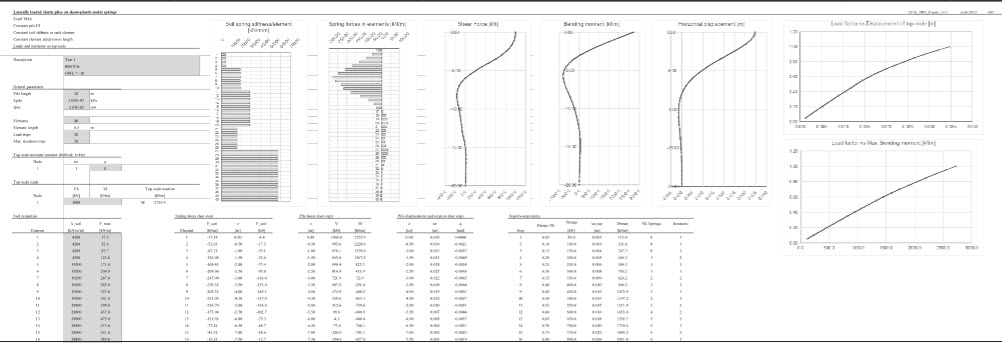Analysis of laterally loaded piles on elasto-plastic spdngs
This is a spreadsheet for the analysis of laterally loaded single elastic piles. The pile-soil interaction is modelled with
elasto-plastic springs defined by their stiffness and maximum force. Free or hxed conditions may be specified at the
pile head.
This soil behaviour model provides excellent results and is usually sufhcient to handle most of the buiding and bridge
foundations design work. However, more advanced p-y or continuum models may be necessary for large rafts, high
loads, offshore structures, unusual geotechnical conditions, cyclic loading, etc. As usual with any tool, proper
engineering judgement is required.
An auxiliary worksheet is included in the file to demonstrate the calculation of spring properties. lt presents an
example that correlates CPT qc values with corrected SPT data and then proceeds to calculate springs' stiffness and
l`lT8XlmUm passive forces,
The program allows the use of elastic piles of any shape, as the pile stiffness must be introduced directly and the soil
springs properties input into the main worksheet already multiplied by their respective influence width.
Second order geometrically non-linear effects (P-Delta) are not taken into account in the analysis. Piles are assumed to
remain elastic throughout the loading process.
The VBA module is, as usual, open source and the code is commented thoroughly.

This is a spreadsheet for the analysis of laterally loaded single elastic piles. The pile-soil interaction is modelled with
elasto-plastic springs defined by their stiffness and maximum force. Free or hxed conditions may be specified at the
pile head.
This soil behaviour model provides excellent results and is usually sufhcient to handle most of the buiding and bridge
foundations design work. However, more advanced p-y or continuum models may be necessary for large rafts, high
loads, offshore structures, unusual geotechnical conditions, cyclic loading, etc. As usual with any tool, proper
engineering judgement is required.
An auxiliary worksheet is included in the file to demonstrate the calculation of spring properties. lt presents an
example that correlates CPT qc values with corrected SPT data and then proceeds to calculate springs' stiffness and
l`lT8XlmUm passive forces,
The program allows the use of elastic piles of any shape, as the pile stiffness must be introduced directly and the soil
springs properties input into the main worksheet already multiplied by their respective influence width.
Second order geometrically non-linear effects (P-Delta) are not taken into account in the analysis. Piles are assumed to
remain elastic throughout the loading process.
The VBA module is, as usual, open source and the code is commented thoroughly.
